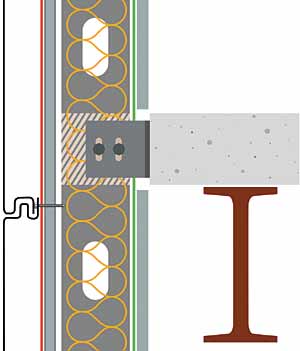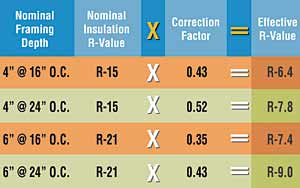Thermal and Moisture Control in Exterior Metal Walls
Metal Studs
A major structural concern with the use of metal studs on
a concrete floor slab is the deflection in the floor that
can be transferred to the exterior wall system. This design
can cause the deflection stresses to pass through the studs
to the single most expensive element of the wall, the outer
wall material. The solution is to move the studs outboard
of the floor slab and use slotted connectors to handle the
deflection (Figure 7). Not only is this is a better design,
it is also a less expensive solution.
|
Insulation
The second component is the thermal barrier, or insulation.
Frequently fiberglass insulation is used in the cavity between
the metal studs. While fiberglass has been tested to provide
reliable thermal protection at a reasonable cost, there are
concerns with its effectiveness when it is used in combination
with metal studs, however. This has been documented in ASHRAE
90.1, which is the basis for many energy codes used in the
U.S. (As of 2005, only 7 states do not reference this standard,
while the other 43 states represent over 75 percent of the
commercial construction in the U.S.) ASHRAE 90.1 requires
reductions in the calculated value of the insulation by using
"correction factors" (Figure 8). Note that a six-inch
stud, filled with fiberglass insulation, at 16-inch centers
has a theoretical R-value of R-21 but is severely reduced
to only a value of R-7.4. The reason for the reduction is
based on the thermal conductivity of the metal studs and the
net effect on the overall heat transfer of the wall system.
|
Vapor Barrier−Retarders
This component of the wall system is climate dependent with
stud cavity insulation. In cold climates, it is located on
the interior of the metal studs. A key to good performance
of a vapor barrier-retarder is continuity of the material,
so as to avoid gaps or breaches. Challenges in maintaining
this continuity occur at floor slabs, behind spandrel beams,
at electrical box penetrations, and at the roof and wall intersection
at parapets (Figure 9) . The condition at the parapet is critical
because it relies on coordinating wall and roofing contractors
to maintain vapor barrier continuity. Electrical distribution
is a challenge because frequently it is done in the stud cavity.
Hence, at every electrical box, the vapor barrier is penetrated,
causing a breach in the vapor barrier continuity.
Exterior Gypsum Sheathing
Exterior grade gypsum sheathing is applied to the exterior
side of the metal studs. There are advantages and challenges
with this type of installation. Advantages include quick enclosure
of the building, fire resistance, and the creation of a continuous
surface to apply building wraps. Challenges associated with
the gypsum sheathing material include the necessary penetrations
to secure the outer material or cladding attachments, and
the resulting exposure of the gypsum core to moisture.











